Apple iPad Pro vs Asus ROG Flow Z13: Which is the better tablet?
Will your next tablet be an iPad or a versatile gaming powerhouse?
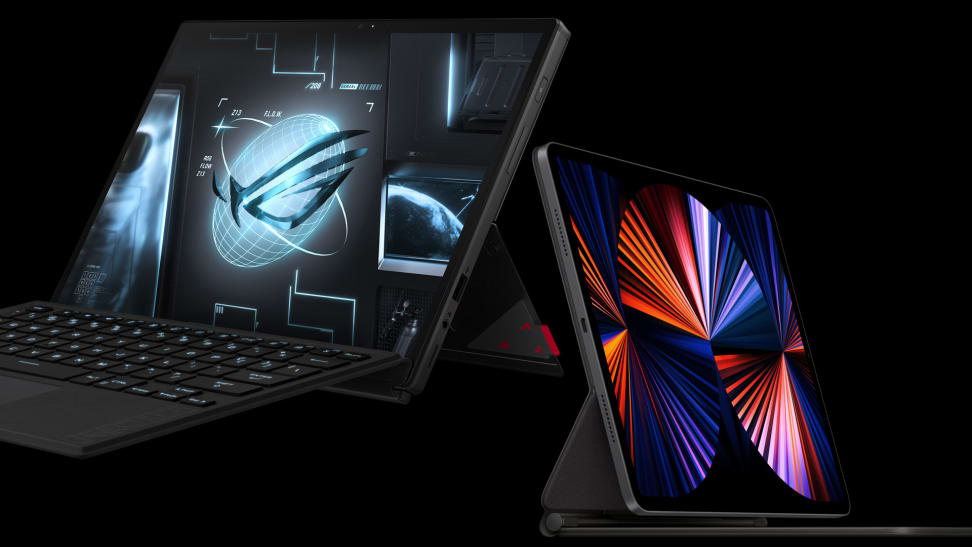 Credit:
Credit:
Products are chosen independently by our editors. Purchases made through our links may earn us a commission.
Apple has had a firm grip on the tablet market for some time now with its various iPad models. Windows and Android tablets have tried to keep up by offering more attractive price points or by directly competing with the iPad (like in the case of the Microsoft Surface Pro 8), but up until the Asus ROG Flow Z13 came along, nothing could punch in the same weight class. Now the iPad Pro 12.9-inch 5th-gen has a serious competitor, a gaming tablet of all things!
Where Apple throws a punch with battery life, Asus counters with processor performance. Where Apple weaves with a high-resolution display, Asus bobs with a better operating system. It’s a hypnotic dance between two similarly spec’d devices, but only one can go all ten rounds.
One thing to note about the below comparison is that we’re looking at the 12.9-inch iPad Pro compared to the Asus ROG Flow Z13. The 12.9-inch iPad is the closest in size and price to the Flow Z13, and it also has a better display. If you’re wondering if you should switch to Windows or stick with iPadOS, read on.
Buy Apple iPad 12.9-inch 5th-gen
Design and display
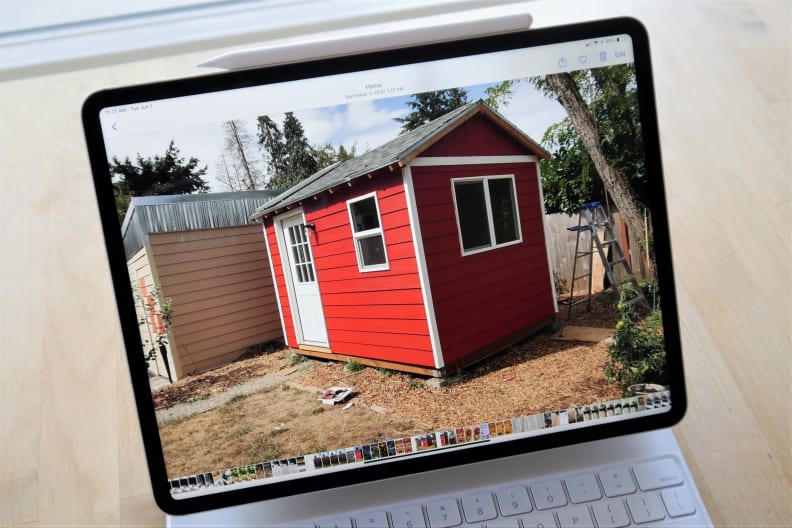
The 12.9-inch version of the 2021 Apple iPad Pro has a bright, vibrant display with Mini-LED technology.
Looks-wise, the iPad Pro and ROG Flow Z13 are drastically different. The iPad Pro has rounded corners with an inviting softness, and the Flow Z13 is sharp and aggressive, so comparing their aesthetics is like comparing apples to zucchini. (The Flow Z13 also has this cool cutout on the back that lets you see a little of the inside components.) But we can compare dimensions and weight.
The ROG Flow Z13 has a 13.4-inch display compared to the iPad Pro’s 12.9-inch display, and it’s slightly thicker and a fair bit heavier: 0.47 inches thick and 2.6 pounds for the Flow Z13; and 0.25 inches thick and 1.5 pounds for the iPad Pro. It’s enough of a difference to notice just by holding or looking at each device side by side, but I personally wasn’t bothered by it. I found the Flow Z13 was just as comfortable to hold and rest on my lap as the iPad Pro.
But there’s one area where the Flow Z13 definitely can’t compete with the iPad Pro: the display. The Z13’s display is nice for a Windows-based tablet, reaching a max 473 nits of brightness and covering 97.7% of the sRGB and 73.4% of the DCI-P3 color gamut. If you’ll be using this tablet mostly for gaming or watching movies, and the occasional sketch or watercolor landscape, this should be more than enough for you. I was impressed by how inky the blacks and how vibrant the colors looked while playing games like Cyberpunk 2077 and watching nature shows like Our Planet on Netflix.
But it might not be enough for a professional artist who primarily uses a tablet for drawing or painting or even light video work. The 12.9-inch iPad Pro has what Apple calls a Liquid Retina XDR display. It can not only support higher resolutions compared to the Flow Z13, but it also supports HDR content up to 1600 nits peak brightness and covers 99% of the DCI-P3 color gamut—which also means better sRGB coverage compared to the Flow Z13, too.
The same Netflix nature shows, action-packed movies, and basically anything else looks better on the iPad Pro, too, since the display uses the same mini-LED technology TVs started using years ago. Except Apple does it better. Better than any OLED display we’ve come across on any laptop or tablet.
Our pick: iPad Pro 12.9-inch
Performance
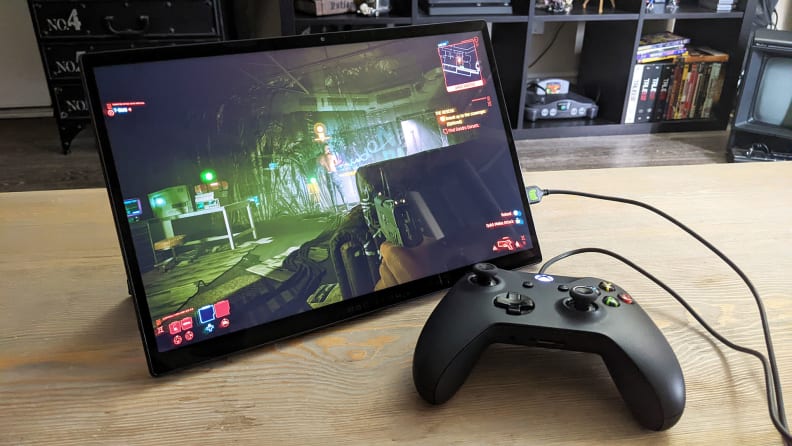
Don't want to game with the included keyboard? Detach it from the ROG Flow Z13, connect a controller, and game on!
It’s not much of a contest between Apple’s M1 and Intel’s Core i9-12900H chips. While both are laptop-grade processors that utilize hybrid architecture, meaning some cores handle high-performance tasks while other cores handle power-efficient tasks, Intel’s chip has more high-performance cores than the M1, which also operates at a higher max frequency.
The M1 chip inside of the 11- and 12-inch iPad Pro has a total of eight cores, four for performance and four for efficiency, and a max clock speed of 3.2GHz. The Core i9-12900H has a total of 14 cores, six for performance and eight for efficiency. The max clock speed of the performance cores is 5.0GHz and the efficient cores top out at 3.8GHz.
Looking at those specs alone, it’s no surprise the i9-12900H speeds straight past the M1. If something like the M1 Max, or even the M1 Pro, was in the iPad Pro, Apple would better match Intel’s performance, but still not surpass it. Even Intel’s Core i5-12500H, which is offered on the base Flow Z13 model, out-specs the M1.
Our pick: Asus ROG Flow Z13
Operating system
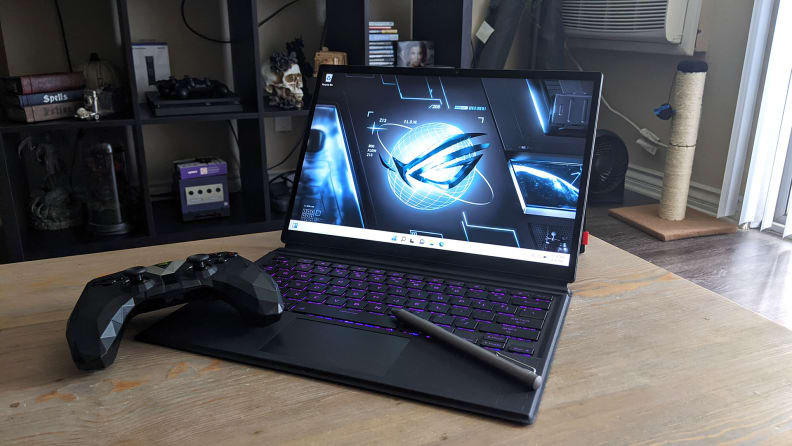
Asus' ROG Flow Z13 is an incredible jack-of-all-trades gaming tablet.
Again, not much of a contest here. While the iPad Pro runs on iPad OS, a pared-down operating system, the ROG Flow Z13 runs on Windows 11, a full-fledged operating system. You can still do the same basic tasks, like web browsing, sending emails, and word processing, on either system, but Windows 11 supports the full version of programs in Adobe Creative Suite and others.
That means the Flow Z13 can run the full version of apps like Adobe Photoshop, while the iPad’s version offers only the key features, like retouching, compositing, and applying effects (and most recently the ability to quickly remove backgrounds). The desktop version has all of that and more, including the recently added Multithreaded and GPU compositing option. Even proprietary Apple programs like GarageBand are paired down on iPad OS.
The Flow Z13 also has the added benefit of being a gaming device, too. Yes, you can play many casual games like CandyCrush on the iPad, but the Flow Z13 is basically a gaming laptop in a tablet form factor, detachable keyboard and all. Play heavy hitters like Cyberpunk 2077, Far Cry 6, Ghostrunner—whatever your heart desires because the Flow Z13 not only has a discrete graphics card, but you can also connect an external GPU to it if you want to increase in-game frame rates.
Asus sells a proprietary external GPU that connects to a special port on the Flow Z13, but the gaming tablet also has a Thunderbolt 4 connection, which supports eGPUs. The iPad Pro doesn’t support eGPUs.
Our pick: Asus ROG Flow Z13
Battery life
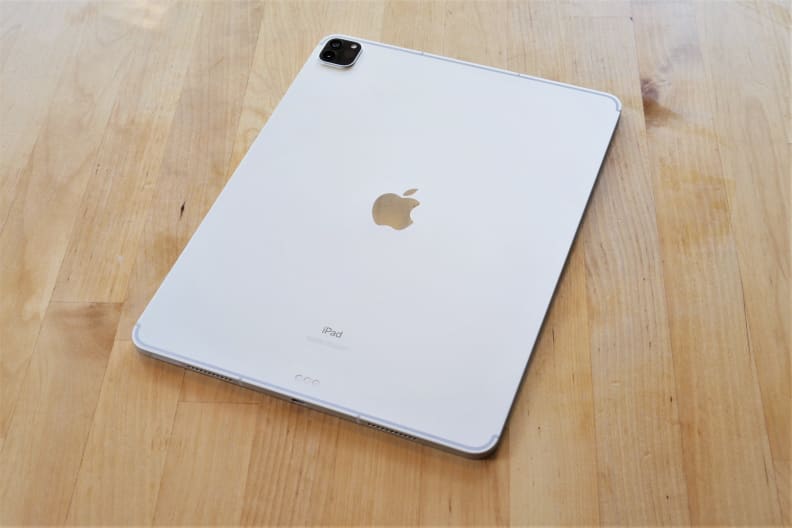
The 2021 iPad Pro looks almost identical to the prior generation.
Another no-contest bullet point here—the Flow Z13 clocks in at about five hours of battery life, while the iPad Pro can last up to twice as long, depending on how you are using the machine.
This is in part due to how much more power-efficient Apple’s M1 chip is compared to Intel’s 12th-gen mobile chips. While the Core i9-12900H used up to 51 Watts when running our usual CPU benchmarks, the Flow Z13 used up to 101W, which is also the maximum power draw of the included AC adapter. Even the Core i5-12500H in the Flow Z13 base model can use up to 95W when pushed.
Our pick: iPad Pro 12.9-inch
Value
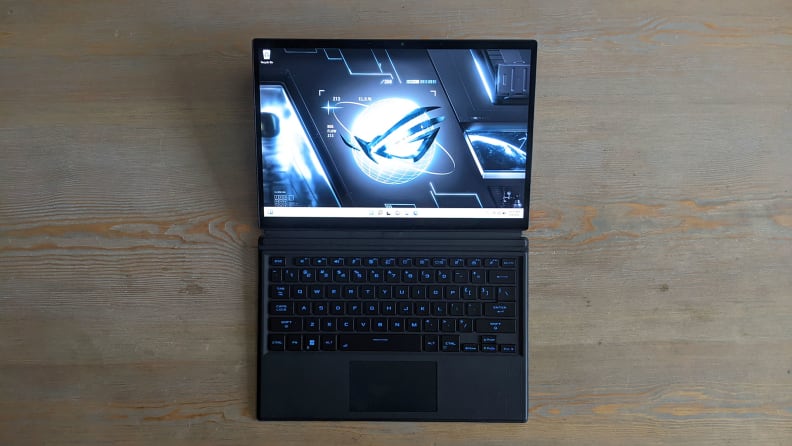
The kickstand attached to the back of the display folds in two directions, one of which lets the tablet lay almost completely flat.
While the base iPad Pro 12.9-inch costs hundreds of dollars less than Asus’ asking price for the high-end ROG Flow Z13 ($1,899.99), if you were to spec it with the same 1TB of SSD storage space as the Flow, the total cost would come to about $100 less, or $1,799.
But here’s the catch—that iPad Pro price doesn’t include a keyboard. Asus includes a folio keyboard with its gaming tablet, but Apple requires you to purchase one of its keyboards separately for $199. Accounting for that additional purchase, the iPad Pro comes to $1998, or $2,148 if you get Apple’s Magic Keyboard instead, which costs $349.
Never mind the fact that you could opt for the mid-range Flow Z13 with an Intel Core i7-12700H and 512GB of SSD storage, and still get a good discrete graphics card for $1,799.99. That’s the same price as an iPad Pro with 1TB of storage, but remember, Asus gives you a keyboard and Apple does not.
The even cheaper Core i5-12500H version lacks a discrete GPU, but its CPU is still faster than the M1. Intel’s Iris Xe integrated graphics are much slower than the M1’s integrated GPU, but again, you can connect an eGPU to the Flow Z13, but not the iPad Pro.
While some of this is obviously subjective, given the better performance and operating system, more configuration options, and better overall versatility, a top-of-the-line ROG Flow Z13 gaming tablet is a much better value than the iPad Pro 12.9-inch tablet.
Our pick: Asus ROG Flow Z13
And the winner is…
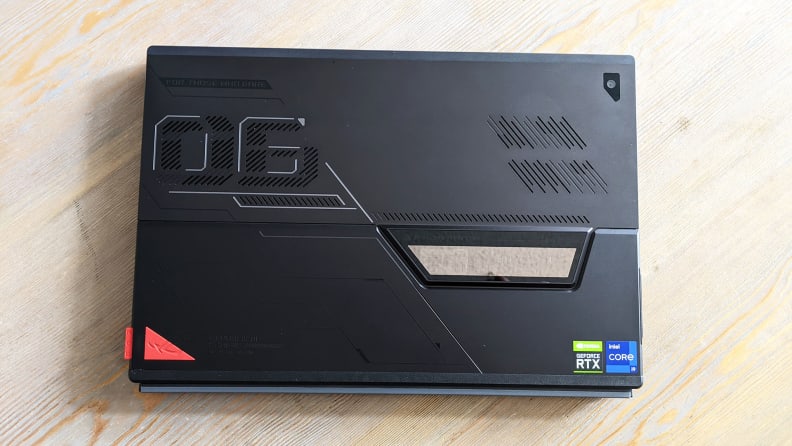
The Flow Z13 looks sleek, futuristic, and just so cool.
The Asus ROG Flow Z13 may be designed for a niche gaming and artist audience, but it’s undeniable how much more you get out of it versus the iPad Pro. I’ll caveat this by saying the Flow Z13’s five-hour battery life is disappointing for an otherwise incredible machine, but for nearly everything else the iPad Pro can do, the Flow Z13 can do it better. Much better.
CPU performance is no-contest, there’s an included keyboard, which is nice to use, and the gaming tablet runs on Windows 11. So not only can the Flow Z13 function as a gaming laptop, but it also has a full-fledged operating system that can run the full versions of Adobe programs, unlike the iPad Pro. If you’ve been waiting for a powerful tablet that’s not the Microsoft Surface, you probably hear the Flow Z13 beckoning you to take it home.
But if you’re already deep in the Apple ecosystem, you need more battery life, or you want a very flashy display, the iPad Pro may be the right choice for you. Most Apple folks probably don’t want to start the switch over to Windows, especially if having a completely seamless workflow is non-negotiable. If you use programs like Final Cut Pro, GarageBand, Procreate, or other programs that exist only within the Mac/iPad ecosystem, or if you think the Apple Pencil is the best stylus ever made, the iPad Pro is likely your super-tablet of choice.
Platform agnostic users, gamers who have moved past gaming desktop PCs, or anyone else who loves a robust, versatile device should seriously consider the Asus ROG Flow Z13 gaming tablet.
Buy Apple iPad 12.9-inch 5th-gen
The product experts at Reviewed have all your shopping needs covered. Follow Reviewed on Facebook, Twitter, Instagram, TikTok, or Flipboard for the latest deals, product reviews, and more.
Prices were accurate at the time this article was published but may change over time.


